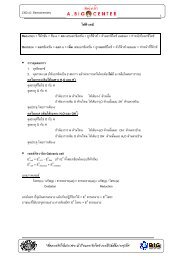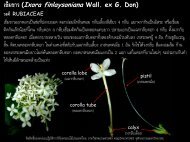Sample Preparation for Volatile Compounds (VOCs)
Sample Preparation for Volatile Compounds (VOCs)
Sample Preparation for Volatile Compounds (VOCs)
You also want an ePaper? Increase the reach of your titles
YUMPU automatically turns print PDFs into web optimized ePapers that Google loves.
<strong>Sample</strong> <strong>Preparation</strong> <strong>for</strong><br />
<strong>Volatile</strong> <strong>Compounds</strong><br />
(<strong>VOCs</strong>)
<strong>Sample</strong> <strong>Preparation</strong> <strong>for</strong> <strong>VOCs</strong><br />
Organic compounds; P ≥ 0.1 mmHg at<br />
20°C<br />
~ 8% of total samples<br />
GC analyses<br />
Petroleum, petrochemical, food, flavor and<br />
fragrances, and environmental fields<br />
Collection/Transport<br />
Introduction w/o treatment<br />
<strong>Preparation</strong>/Introduction<br />
Measurement<br />
Overall accuracy<br />
Reliable result
Typical Sampling and <strong>Sample</strong> <strong>Preparation</strong> Method <strong>for</strong><br />
<strong>VOCs</strong><br />
<strong>Sample</strong> preparation<br />
method<br />
Grab sampling<br />
Solid-phase trapping<br />
(SPE)<br />
Liquid trapping<br />
(Impinging)<br />
Principle of technique<br />
Gaseous sample is pulled<br />
or pumped into an<br />
evacuated metal bulb,<br />
canister, plastic bag, or<br />
syringe<br />
Gaseous sample is passed<br />
an adsorbent tube such as<br />
silica gel or activated<br />
carbon; trapped analytes<br />
are eluted with strong<br />
solvent<br />
Gaseous sample is<br />
bubbled through a solution<br />
or solvent <strong>for</strong> which the<br />
analytes have a higher<br />
affinity<br />
Comments<br />
Mostly <strong>for</strong> <strong>VOCs</strong> in air,<br />
samples are returned to<br />
laboratory, analytes are<br />
isolated and<br />
concentrated by cold<br />
trapping techniques<br />
For semivolatile organic<br />
compounds in air.<br />
Popular sorbents include<br />
silica gel, alumina,<br />
porous polymer (Tenax,<br />
PUF) and carbon<br />
Flow rate may cause<br />
foaming or aerosols
Typical Sampling and <strong>Sample</strong> <strong>Preparation</strong> Method <strong>for</strong><br />
<strong>VOCs</strong><br />
<strong>Sample</strong> preparation<br />
method<br />
Headspace sampling<br />
Purge & trap<br />
(dynamic headspace)<br />
Principle of technique<br />
A solid or liquid sample is<br />
placed in a closed glass vial<br />
until equilibrium. Analytes<br />
partition themselves<br />
between a gas phase and a<br />
solid or liquid phase; gas<br />
phase is sampled and<br />
injected into a GC<br />
A solid or liquid sample is<br />
placed in a closed<br />
container, <strong>VOCs</strong> are<br />
continually purged by an<br />
inert gas and subsequently<br />
trapped by SPE sorbent<br />
and then thermal desorbed<br />
into GC (Thermal<br />
desorption)<br />
Comments<br />
For determining trace<br />
concentrations of <strong>VOCs</strong> in<br />
samples that are difficult to<br />
handle by conventional GC.<br />
Increasing temperature,<br />
salting out, adjusting pH,<br />
would shift equilibrium of<br />
analytes from the matrix<br />
For determining trace<br />
concentrations of <strong>VOCs</strong> in<br />
samples and <strong>for</strong> analytes<br />
that have unfavorable<br />
partition coefficient in static<br />
headspace sampling
Typical Sampling and <strong>Sample</strong> <strong>Preparation</strong> Method <strong>for</strong><br />
<strong>VOCs</strong><br />
<strong>Sample</strong><br />
preparation<br />
method<br />
Thermal desorption<br />
Principle of technique<br />
Used with purge & trap<br />
and SPME to concentrate<br />
<strong>VOCs</strong>; sorbent is rapidly<br />
heated and analytes are<br />
transferred to a GC<br />
Comments<br />
Typical sorbents include<br />
Tanex TA, glass beads, and<br />
Carbosieve, Carboxen, and<br />
Carbotrap<br />
Pyrolysis<br />
SPME<br />
Nonvolatile large molecule<br />
samples such as polymers<br />
and plant fibers are<br />
thermally degraded to<br />
cleave linkages and<br />
produce smaller, more<br />
volatile molecules that are<br />
swept to GC<br />
Already discussed<br />
Degradation have defined<br />
mechanisms and sample<br />
may break apart in a<br />
predictable manner<br />
providing structural info and<br />
fingerprint profiles about<br />
starting compound<br />
Already discussed
Tedlar Air & Gas<br />
Sampling Bags<br />
Impringer<br />
Canister
Headspacce Sampling<br />
Static Headspace (Equilibrium<br />
Headspace)<br />
– The sample, placed in a closed container may<br />
be in contact and in equilibrium with the<br />
extracting gas<br />
Dynamic Headspace (Purge & Trap)<br />
– The volatile compounds may be stripped off in<br />
a continuous flow of an inert gas<br />
‣ Ideal <strong>for</strong> dirty samples, solid materials, samples<br />
with high boiling point analytes of no interest,<br />
samples with high water content, and samples<br />
that are difficult to handle by conventional GC
Static Headspace<br />
GC
Basic of Static Headspace<br />
Cg, , Vg<br />
Cs, Vs<br />
Partition Coefficient (K) = C s /C g<br />
Phase Ratio (β)(<br />
) = V g /V s<br />
C s =concentration of analyte in sample phase<br />
C g =concentration of analyte in gas phase<br />
Vs=volume of sample phase<br />
Vg=volume of gas phase<br />
K K and β are important variables in headspace analysis.<br />
C<br />
g<br />
= K<br />
C<br />
o<br />
+ β
K-Value Air-Water System (40 o C)<br />
Compound<br />
Cyclohexane<br />
n-Hexane<br />
Tetrachloroethylene<br />
Chloro<strong>for</strong>m<br />
o-Xylene<br />
Toluene<br />
Benzene<br />
Dichloromethane<br />
n-butyl acetate<br />
Ethyl acetate<br />
Methyl ethyl ketone<br />
n-Butanol<br />
Isopropanol<br />
Ethanol<br />
1,3-Dioxane<br />
K Value<br />
0.077<br />
0.14<br />
1.48<br />
1.65<br />
2.44<br />
2.82<br />
2.90<br />
5.65<br />
31.4<br />
62.4<br />
139.5<br />
647<br />
825<br />
1355<br />
1618<br />
Boiling Point ( o C)<br />
81<br />
69<br />
121<br />
61.1<br />
145<br />
111<br />
80<br />
40<br />
126<br />
77<br />
79.6<br />
117.7<br />
82.4<br />
78.3<br />
106
Optimizing Static Headspace<br />
Extraction<br />
efficiency<br />
Sensitivity<br />
Quantitation<br />
Reproducibility<br />
Vial/sample<br />
volume (β)(<br />
Temperature<br />
Pressure<br />
Matrix
Partition Coefficient (K)<br />
Maximize the concentration of the volatile<br />
components C g in the headspace<br />
Lower K by changing the temperature at<br />
which the vial is equilibrated or by<br />
changing the composition of the sample<br />
matrix.<br />
C g<br />
C g<br />
K<br />
β
Headspace sensitivity<br />
1. EtOH<br />
2. Methyl ethyl ketone<br />
3. Toluene<br />
4. N-hexane<br />
5. Tetrachloroethylene<br />
High K -- Temp<br />
B. Kolb, L.S. Ettre, “Static Headspace- Gas Chromatography: Theory and<br />
Practice,” Wiley-VCH, New York. 1997.
Headspace sensitivity<br />
1. Cyclohexane<br />
2. 1,4 dioxane<br />
β= 3.46<br />
With salt<br />
β = 21.3 β = 3.46<br />
Low K -- β<br />
B. Kolb, L.S. Ettre, “Static Headspace- Gas Chromatography: Theory and<br />
Practice,” Wiley-VCH, New York. 1997.
Static Headspace Sampling<br />
Gas tight syringe<br />
Autosampler<br />
–Balance-pressure system<br />
–Pressure-loop system<br />
Tekmar 7000HT Static<br />
Headspace autosampler
Gas Tight Syringe<br />
Step 1<br />
<strong>Sample</strong> reaches<br />
equilibrium<br />
Step 2<br />
<strong>Sample</strong> is extracted<br />
from headspace<br />
Step 3<br />
<strong>Sample</strong> is injected
Gas Tight Syringe
Needle Point Style<br />
#2<br />
22/20-degree beveled needle point recommended <strong>for</strong> septum<br />
penetration.<br />
#3<br />
90-degree needle point <strong>for</strong> use with HPLC injection valves<br />
and <strong>for</strong> sample pipetting<br />
#5<br />
Conical needle with side port <strong>for</strong> penetration of septa.
Advantage<br />
– Simplicity<br />
Disadvantage<br />
Gas Tight Syringe<br />
– The loss of the substances<br />
– No reproducibility
Autosampler - Balance Pressure<br />
System<br />
<strong>Sample</strong> reaches<br />
equilibrium<br />
Pressurization of<br />
injection<br />
<strong>Sample</strong> is extracted<br />
and injected
Autosampler - Pressure-Loop System<br />
Inlet<br />
Step 12<br />
3<br />
<strong>Sample</strong> reaches<br />
is<br />
extracted<br />
equilibrium/pressurization<br />
from injected<br />
headspace<br />
Loop<br />
To Column
Dynamic Headspace<br />
Continuous gas extraction<br />
Volatilized (purged) analytes can be<br />
trapped by an adsorbent or<br />
cryogenic trapping<br />
For substances which are too low in<br />
concentration or have unfavorable<br />
partition coefficients <strong>for</strong> their<br />
determination by static headspace
Purge and Trap<br />
Purging gas is bubbled below<br />
the surface of a liquid sample<br />
using a fritted orifice to<br />
produce finely dispersed<br />
bubbles<br />
The <strong>VOCs</strong> are transferred<br />
from the aqueous phase to<br />
the vapor phase<br />
The gas flow sweeps the<br />
vapor through trap containing<br />
adsorbent materials which<br />
retain the <strong>VOCs</strong><br />
The retained <strong>VOCs</strong> are<br />
thermally desorbed and<br />
analyzed by GC
Schematic of Purge & Trap<br />
Heat<br />
To GC column<br />
Carrier gas<br />
Purge gas<br />
Valve<br />
Trap Vent<br />
HP-7675A
Purge and Trap System<br />
Tekmar 3100 Purge and Trap<br />
<strong>Sample</strong> Concentrator<br />
2016/2032 Purge and Trap<br />
Autosampler
Purge and Trap Glassware
Trapping<br />
Adsorbent resins<br />
– Purge & Trap<br />
– Direct sampling<br />
Sufficient capacity – Breakthrough<br />
volume<br />
– Bed volume<br />
– Flow rate<br />
Affinity of resin <strong>for</strong> water<br />
Back pressure
Trap<br />
Polymers<br />
– Tenax<br />
– Polystyrene<br />
– Polyurethane foams<br />
Carbon<br />
– Graphitized carbon<br />
black<br />
– Charcoal<br />
– Carbon sieves<br />
Silica gel<br />
Alumina<br />
Tenax TA<br />
– 2,6-diphenylene oxide<br />
Tenax GR<br />
– Tenax TA + 30% graphite<br />
Carbotrap, Carbotrap<br />
C<br />
– Graphitized carbon blacks<br />
Carboxen 569,<br />
Carbosieve SIII<br />
– Carbon molecular<br />
sieves<br />
Glass Beads
Tenax TA<br />
A porous polymer resin based on<br />
2,6-diphenylene oxide<br />
High temperature limit of 350 o C<br />
– Tenax degrades if react with O 2 at high<br />
temperature – abundance of phenolic<br />
compounds and oligomers<br />
Low affinity <strong>for</strong> water<br />
– Useful <strong>for</strong> high moisture content<br />
samples including the analysis of<br />
volatile organic compounds in water
Selection of Adsorbents<br />
Types of analytes<br />
The physical properties of the<br />
adsorbent<br />
Breakthrough info.<br />
John J. Manura, Selection and Use Of Adsorbent Resins For<br />
Purge and Trap Thermal Desorption Applications<br />
Scientific Instrument Services, Inc.<br />
http://www.sisweb.com/referenc/applnote/app-32.htm<br />
Scientific Instrument Services, Inc.<br />
http://www.sisweb.com
Breakthrough<br />
The breakthrough volume <strong>for</strong> a compound<br />
on a given adsorbent and at a given<br />
temperature is defined as the calculated<br />
volume of carrier gas per gram of<br />
adsorbent resin which causes the analyte<br />
molecules to migrate from the front of the<br />
adsorbent bed to the back of the<br />
adsorbent bed.<br />
V<br />
(L/g)<br />
B<br />
=<br />
( t × F)<br />
R<br />
m<br />
A<br />
t R = Retention time (min)<br />
F = Flow rate (L/min)<br />
m A = Adsorbent mass (g)
Breakthrough<br />
Scientific Instrument Services, Inc.
Calculation of Breakthrough Volume<br />
t R<br />
V<br />
B<br />
=<br />
( t × F)<br />
R<br />
m<br />
A<br />
−<br />
DV<br />
V S = V B * 0.5<br />
V F = V B * 2<br />
V S<br />
V F
Breakthrough Volumes of Alcohols (C1 – C11) on Tenax<br />
TA<br />
0.4<br />
5<br />
20<br />
120
Breakthrough Volumes of Alcohols by Tenax TA
Desorption Chart
Breakthrough Data<br />
Hydrocarbons<br />
Alcohols<br />
Alkenes<br />
Alcohols & Glycols<br />
Acetates<br />
Acids<br />
Aldehydes<br />
Ketones<br />
Halogens<br />
Amines<br />
Aromatics and<br />
Terpenes<br />
Water<br />
Scientific Instrument Services, Inc.<br />
http://www.sisweb.com
Thermal Desorption (TD)<br />
Thermally desorb analytes from the<br />
adsorbents (P&T, direct sampling)<br />
Direct Thermal extraction<br />
– <strong>Volatile</strong>s from solid samples<br />
Thermal desorption – To GC<br />
– Transfer line<br />
– Focusing – Improved resolution
Thermal Desorption/Extraction<br />
Glass wool<br />
plug<br />
0.4 mm i.d.<br />
Solid<br />
sample<br />
Adsorbent<br />
resin<br />
10 cm<br />
Temp. ~300 o C<br />
Glass wool<br />
plug<br />
Temp. < 200 o C<br />
Direct Thermal<br />
Extraction<br />
Thermal<br />
Desorption
Short Path Thermal Desorption
Tempearture/Time<br />
Desorption<br />
temperature<br />
– Enough to<br />
volatilize the<br />
organic compound<br />
without degrading<br />
them and without<br />
producing<br />
unwanted<br />
artifacts<br />
– Temperature rate<br />
Desorption time<br />
– <strong>Sample</strong> matrix<br />
– <strong>Sample</strong> size<br />
– Interaction strength<br />
between analyte<br />
and the solid<br />
surface<br />
– Desorption<br />
temperature<br />
– Diffusion time of<br />
analyte out of the<br />
sample
Reduce Band Broadening:<br />
Focusing<br />
PTV<br />
Retention Gap<br />
Cryogenic focusing<br />
Cryo-Trapping<br />
Scientific Instrument Services, Inc.
Cryo-focusing<br />
Cryo-focusing is a technique <strong>for</strong><br />
introducing samples from purge-and<br />
and-<br />
trap concentrators into capillary GC<br />
columns<br />
It enables samples desorbed from<br />
adsorbent traps to be introduced into<br />
narrow-bore columns without losing<br />
any resolution of the column
Single Stage Thermal Desorption<br />
GC Detector<br />
<strong>Sample</strong> Tube<br />
GC Analytical Column<br />
Two-Stage Thermal Desorption<br />
Carrier<br />
Inlet<br />
Split<br />
Cold<br />
Trap<br />
Desorb Flow Split<br />
GC Detector<br />
Hot <strong>Sample</strong> Tube<br />
Carrier<br />
Inlet<br />
Hot<br />
Trap<br />
Carrier<br />
Inlet<br />
GC Analytical Column
Cryo-Trapping<br />
Scientific Instrument Services, Inc.
Thermal Desorption<br />
Analysis without the use of solvent<br />
– Analysis of 100% instead of aliquot<br />
– Elimination of solvent peak in the<br />
chromatogram enables the analysis of<br />
early eluted volatile analytes that are<br />
not masked by the solvent<br />
– Elimination of solvent reduction, no<br />
evaporation of solvent to the<br />
environment, and no waste
Applications<br />
<strong>VOCs</strong> from water/soil (EPA Method 502.1,<br />
503.1, 8030A, SW-846 Method 5030A)<br />
<strong>VOCs</strong> from biological fluids (urine, plasma,<br />
saliva, tissues)<br />
Fragrances, flavors<br />
Forensic investigation (arson accelerants)
Pyrolysis<br />
Next stage in thermal extraction technique<br />
Bond dissociation at very high<br />
temperatures (600-800<br />
o C) ) and break<br />
apart into smaller and simpler volatile<br />
molecules in a predictable manner<br />
By measuring the fragments, the<br />
molecular composition of the original<br />
sample can be reconstructed<br />
Polymer defects, variations, and<br />
degradation mechanisms
Pyrolysis<br />
aH<br />
bH<br />
As sample is heated, the weaker bond<br />
breaks first <strong>for</strong>ming free radicals<br />
C C<br />
dH<br />
Cl eH<br />
Polyvinyl Polyethylene chloride<br />
Polystyrene<br />
If C-C C C bonds are the weakest, the<br />
polymer will break into oligomeric<br />
fragments including monomers<br />
If the side group bond is weaker,<br />
the group is removed from the<br />
chain be<strong>for</strong>e fragmented, so the<br />
monomeric identity is lost<br />
The materials can be heated to a relatively low temperature <strong>for</strong><br />
desorption of intact small molecules including solvents, excess<br />
reagents, residual monomers, and additive such as plasticizer
Pyrolysis - Applications<br />
Synthetic polymers (Polyvinyl<br />
chloride, Polystyrene, Polyester)<br />
Natural polymers<br />
– Plant fibers (Cellulose, Cotton)<br />
– Animal fibers (Wool, Silk)<br />
Dried paints<br />
Cosmetic samples
















